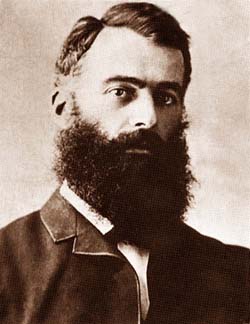Lawrence Hargrave
Lawrence Hargrave (29 January 1850 – 6 July 1915) was an Australian engineer, inventor, and aviation pioneer. His research and experimentation led to significant advancements in the field of aerodynamics, and he is best known for his work on box kites and the invention of the rotary engine. Hargrave's contributions to the development of aviation have cemented his place as a key figure in the history of flight.
Early Life[edit | edit source]
Lawrence Hargrave was born in Greenwich, England, to John Fletcher Hargrave, a judge, and Ann Hargrave. In 1856, the Hargrave family emigrated to Australia, settling in Sydney. Hargrave was educated at the Queen Elizabeth's Grammar School in Kirkby Lonsdale, Westmorland. He showed an early interest in mechanical engineering and invention.
Career and Inventions[edit | edit source]
Hargrave's career was marked by his relentless pursuit of knowledge and innovation in the field of aviation. He worked as an apprentice in the engineering workshops of the Australian Steam Navigation Company before embarking on several exploratory expeditions. However, it was his experiments with kites and engines that garnered him the most recognition.
Box Kites[edit | edit source]
Hargrave is perhaps most famous for his development of the box kite in 1893. This design significantly improved the lift-to-drag ratio of kites and had a profound impact on the development of aviation. The principles of the box kite were later applied to the design of the first successful powered aircraft.
Rotary Engine[edit | edit source]
In addition to his work with kites, Hargrave invented a type of rotary engine that was more lightweight and efficient than existing engines at the time. Although his engine did not gain widespread use in aviation, it represented a significant step forward in engine design and demonstrated Hargrave's innovative approach to problem-solving.
Legacy[edit | edit source]
Lawrence Hargrave's dedication to aviation and his pioneering work in aerodynamics have left a lasting legacy. He was a member of the Royal Society of New South Wales and was offered, but declined, knighthood. Hargrave chose to share his discoveries freely, without seeking patents, believing that such knowledge should benefit all of humanity. This altruistic approach contributed to the rapid advancement of aviation technology.
Hargrave's inventions and the principles he discovered are commemorated in various ways, including the naming of Hargrave Street in Paddington, Sydney, and the Lawrence Hargrave Drive in New South Wales. His life and work are celebrated in Australia and around the world as a testament to human ingenuity and the spirit of exploration.
Death[edit | edit source]
Lawrence Hargrave died of peritonitis on 6 July 1915 in Milsons Point, New South Wales, Australia. His contributions to the field of aviation continued to influence developments in the industry long after his death.
Search WikiMD
Ad.Tired of being Overweight? Try W8MD's physician weight loss program.
Semaglutide (Ozempic / Wegovy and Tirzepatide (Mounjaro / Zepbound) available.
Advertise on WikiMD
|
WikiMD's Wellness Encyclopedia |
| Let Food Be Thy Medicine Medicine Thy Food - Hippocrates |
Translate this page: - East Asian
中文,
日本,
한국어,
South Asian
हिन्दी,
தமிழ்,
తెలుగు,
Urdu,
ಕನ್ನಡ,
Southeast Asian
Indonesian,
Vietnamese,
Thai,
မြန်မာဘာသာ,
বাংলা
European
español,
Deutsch,
français,
Greek,
português do Brasil,
polski,
română,
русский,
Nederlands,
norsk,
svenska,
suomi,
Italian
Middle Eastern & African
عربى,
Turkish,
Persian,
Hebrew,
Afrikaans,
isiZulu,
Kiswahili,
Other
Bulgarian,
Hungarian,
Czech,
Swedish,
മലയാളം,
मराठी,
ਪੰਜਾਬੀ,
ગુજરાતી,
Portuguese,
Ukrainian
Medical Disclaimer: WikiMD is not a substitute for professional medical advice. The information on WikiMD is provided as an information resource only, may be incorrect, outdated or misleading, and is not to be used or relied on for any diagnostic or treatment purposes. Please consult your health care provider before making any healthcare decisions or for guidance about a specific medical condition. WikiMD expressly disclaims responsibility, and shall have no liability, for any damages, loss, injury, or liability whatsoever suffered as a result of your reliance on the information contained in this site. By visiting this site you agree to the foregoing terms and conditions, which may from time to time be changed or supplemented by WikiMD. If you do not agree to the foregoing terms and conditions, you should not enter or use this site. See full disclaimer.
Credits:Most images are courtesy of Wikimedia commons, and templates, categories Wikipedia, licensed under CC BY SA or similar.
Contributors: Prab R. Tumpati, MD

